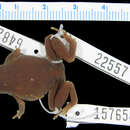en
names in breadcrumbs


Kalophrynus subterrestris és una espècie de granota que viu a Indonèsia i Malàisia.
Es troba amenaçada d'extinció per la pèrdua del seu hàbitat natural.
Kalophrynus subterrestris és una espècie de granota que viu a Indonèsia i Malàisia.
Es troba amenaçada d'extinció per la pèrdua del seu hàbitat natural.
Kalophrynus subterrestris is a species of frog in the family Microhylidae. It endemic to Borneo where it is known from Sabah and Sarawak (Malaysia),[3][4] although it is also presumed to be present in Kalimantan (Indonesia) and Brunei.[3] Common names burrowing grainy frog[3][5] and Labang sticky frog have been coined for this species.[4]
Males measure 21–23 mm (0.83–0.91 in) and females 26–27 mm (1.0–1.1 in) in snout–vent length. The tympanum is distinct. The finger and toe tips are rounded. The toes have basal webbing. Skin is coarsely granular. The dorsum is dark gray, without darker or lighter markings. The sides of body are orange in the groin. The venter has dusky mottling anteriorly; the belly is white.[2][4]
Natural habitats of Kalophrynus subterrestris are lowland, tropical moist forests below 300 m (980 ft) above sea level.[1] They typically occur under leaf litter or in burrows (hence the specific name subterrestris).[4] The species is relatively abundant locally, but it does not occur in modified habitats; habitat loss from clear-cutting is a threat.[1]
Kalophrynus subterrestris is a species of frog in the family Microhylidae. It endemic to Borneo where it is known from Sabah and Sarawak (Malaysia), although it is also presumed to be present in Kalimantan (Indonesia) and Brunei. Common names burrowing grainy frog and Labang sticky frog have been coined for this species.
Kalophrynus subterrestris es una especie de anfibios de la familia Microhylidae.
Se encuentra en Indonesia y Malasia.
Se encuentra amenazada de extinción por la pérdida de su hábitat natural.
Kalophrynus subterrestris es una especie de anfibios de la familia Microhylidae.
Kalophrynus subterrestris Kalophrynus generoko animalia da. Anfibioen barruko Microhylidae familian sailkatuta dago, Anura ordenan.
Kalophrynus subterrestris Kalophrynus generoko animalia da. Anfibioen barruko Microhylidae familian sailkatuta dago, Anura ordenan.
Kalophrynus subterrestris est une espèce d'amphibiens de la famille des Microhylidae[1].
Cette espèce est endémique de l'île de Bornéo. Elle se rencontre jusqu'à 300 m d'altitude[1].
Kalophrynus subterrestris mesure jusqu'à 23 mm pour les mâles et jusqu'à 27 mm pour les femelles. Son dos est gris foncé, les flancs étant plus clairs. Certains individus présentent au niveau de l'aine de petites taches noires[2].
Son nom d'espèce, du préfixe latin sub-, « sous, au-dessous de », et terrestris, « terrestre, lui a été donné en référence au fait que deux spécimens ont été découverts dans des terriers[2].
Kalophrynus subterrestris est une espèce d'amphibiens de la famille des Microhylidae.
Kalophrynus subterrestris é uma espécie de anfíbio da família Microhylidae.
Pode ser encontrada nos seguintes países: Indonésia e Malásia.[1]
Os seus habitats naturais são: florestas subtropicais ou tropicais húmidas de baixa altitude e marismas intermitentes de água doce.[1]
Está ameaçada por perda de habitat.[1]
Kalophrynus subterrestris é uma espécie de anfíbio da família Microhylidae.
Pode ser encontrada nos seguintes países: Indonésia e Malásia.
Os seus habitats naturais são: florestas subtropicais ou tropicais húmidas de baixa altitude e marismas intermitentes de água doce.
Está ameaçada por perda de habitat.
Kalophrynus subterrestris là một loài ếch trong họ Nhái bầu. Nó được tìm thấy ở Indonesia và Malaysia. Các môi trường sống tự nhiên của chúng là các khu rừng ẩm ướt đất thấp nhiệt đới hoặc cận nhiệt đới và đầm nước ngọt có nước theo mùa. Loài này đang bị đe dọa do mất môi trường sống.
Kalophrynus subterrestris là một loài ếch trong họ Nhái bầu. Nó được tìm thấy ở Indonesia và Malaysia. Các môi trường sống tự nhiên của chúng là các khu rừng ẩm ướt đất thấp nhiệt đới hoặc cận nhiệt đới và đầm nước ngọt có nước theo mùa. Loài này đang bị đe dọa do mất môi trường sống.